What is Dual Shield Welding? How Does it Work? (2024 Guide)
Last Updated on
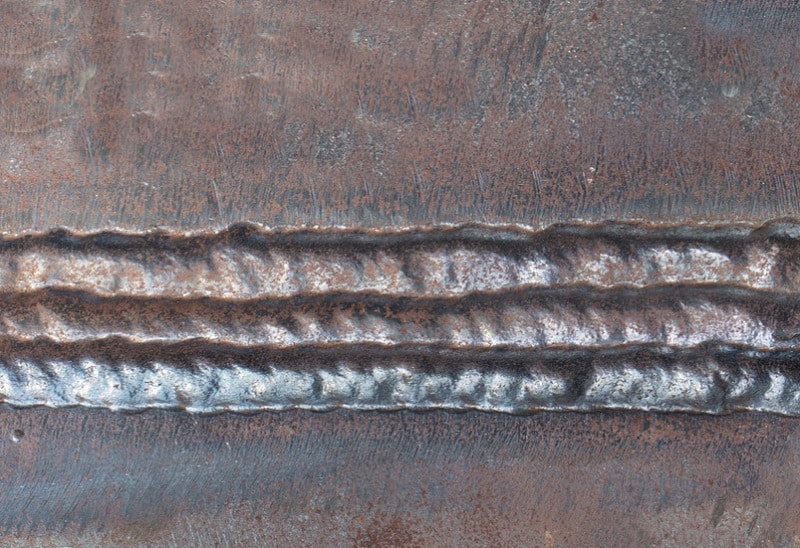
Dual shield welding, also known as FCAW (Flux Core Arc Welding), is a procedure where you use an arc between the weld pool formed from the metal shields and the consumable anode. The pool is protected from an externally supplied gas by a flux in the tubular anode with extra protection.
The process is known as double shielding as the two layers of shielding are offered to the weld in the welding procedure.
In this article, we shall discuss everything you need to know about dual shield welding. We’ll also compare this welding procedure to MIG welding. If you want to know more, then read on!
What is Flux Core Arc Welding (Dual Shield Welding)?
Double shield welding uses an external protecting gas and a slag system to safeguard the arc from the surroundings. The cable used during the procedure is usually delineated as a “dual shielded’ anode.
The cable adds the alloy elements level you desire to the puddle formed by the molten metal. It influences the structural characteristics of the weld. The wire’s core metal also generates a slag that covers the weld. It’s similar to the self-shielded cables.
A shielding gas offers added protection by covering the arc to stop contamination from the atmosphere. During the procedure, two protective gases are used. They are:
- 100% Carbon Dioxide
- A mixture of 15 to 25% CO2 and 75 to 85% Argon
Using a protective gas significantly enhances the usability of the cables and the operator’s attraction. Most shielding wire types contain a little droplet arc that conveys in a sleek, spraying arc. For all wire types used in dual shield welding, the suggested polarity is DC+.
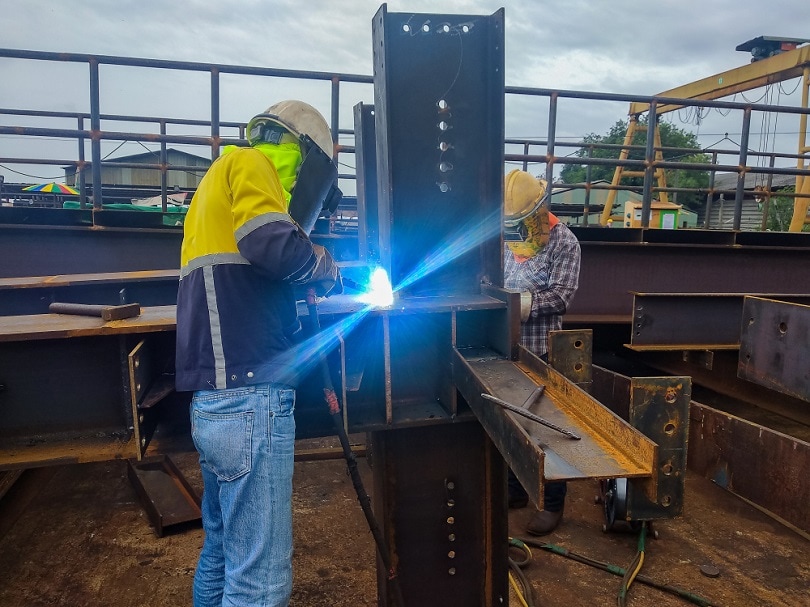
Usually, Flux Core Arc Welding is ideal indoors. It’s because the arc provides smoother arc features if done indoors. You can carry out this welding procedure outdoors.
However, you need to be extra cautious to ensure that the wind doesn’t blow the shielding gases away. If the shielding gases are dispersed, then porosity occurs in the final weld.
How Does Dual Shield Welding Work?
Dual shield welding uses the heat produced by an electric arc to melt together the parent metal in the weld joint area. The arc is hit between the constantly-fed cannular cored consumable filler cable and the metal workpiece. To create a weld joint, both the metallic workpiece and the wire melt together.
It’s similar to MAG welding, apart from that dual shield welding uses a hollow, cannular anode filled with flux instead of a solid metal electrode.
The dual shield welding procedure can be split into two types based on the protection technique:
- The first process uses an exterior protection gas
- The second one depends exclusively on the flux core itself for safeguarding the weld area
Generally, the shielding gas is provided externally from a gas cylinder under high pressure. When used, it safeguards the weld pool from oxidation. The slag formed from the melting of flux also shields the weld metal.
Hence the procedure is informally called “dual shield” welding. Primarily, it was designed to weld structural steel. In this welding procedure, the most commonly used protective gases are Carbon Dioxide and a mixture of 25% CO2 and 75% argon, which is the most frequently used blend.
If used in similar settings, the dual shield welding procedure produces welds with more constant mechanical characteristics. This welding process also has fewer faults as compared to MAG or MMA procedures.
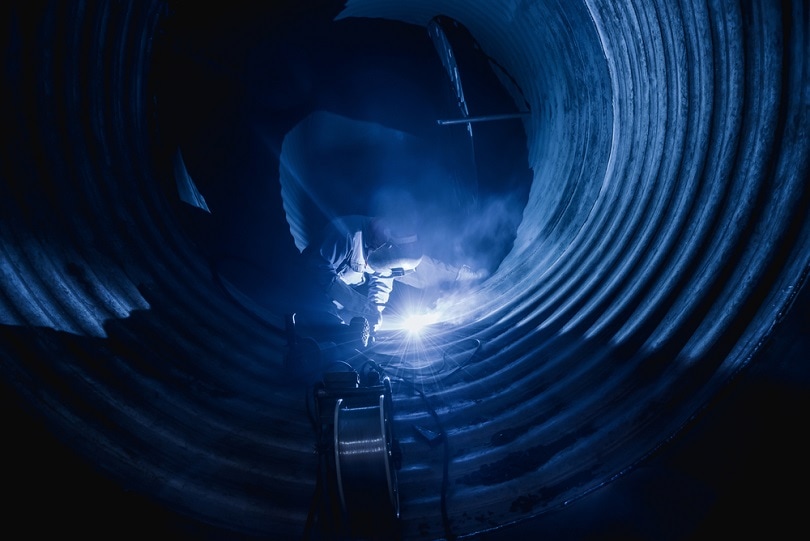
Thanks to the constantly-fed cannular anode, you’ll have higher production rates as compared to the stick electrode or a solid cable. Nevertheless, the gas-shielded technique may not be fit for use when it’s windy. It’s because the interruption to gas protection may lead to lessened weld metal characteristics.
The other version of this procedure doesn’t use an external protection gas. However, it depends on the protection provided by the flux-cored anode itself. Thanks to the anode, it creates a slag that covers and safeguards the melted metal in the weld. It also offers gaseous protection.
The filler cable core consists of fluxing agents that lead to the formation of slag. Also, it has materials that generate protective gases if burned by the heat from the welding arc.
Thanks to the shielding flux, this procedure can be used outside easily even if it’s windy and, therefore, you don’t need an external protective gas. Due to this, the procedure is extremely portable and, therefore, fit for outside welding applications.
Where is Dual Shield Welding Used?
When it comes to welding applications, Flux Core Arc Welding is similar to MIG welding and Manual Metal Arc Welding. Usually, the procedure is controlled manually. Nonetheless, you can mechanize it based on the nature of the welding task.
Most automobiles and machine fabrication industries utilize Flux Core Arc Welding in their assembly lines. In a wide range of compositions, cored, cannular anodes are available for use in double shield welding. They’re more helpful as compared to solid wires. It’s because it’s easy to add alloy elements in powder configuration.
In a wide array of welding applications, gas shielded flux cored cables can easily meet the mechanical property needs. If you compare them, the mechanical properties you can accomplish using self-shielded cored cables are completely limited, with a 700 N total strength of the weld metal.
If you have thicker metals, dual shield welding is the ideal procedure for you. You can also use this procedure where you need to apply out-of-position welds. Usually, they leave a melted slag that turns solid faster as compared to the weld pool.
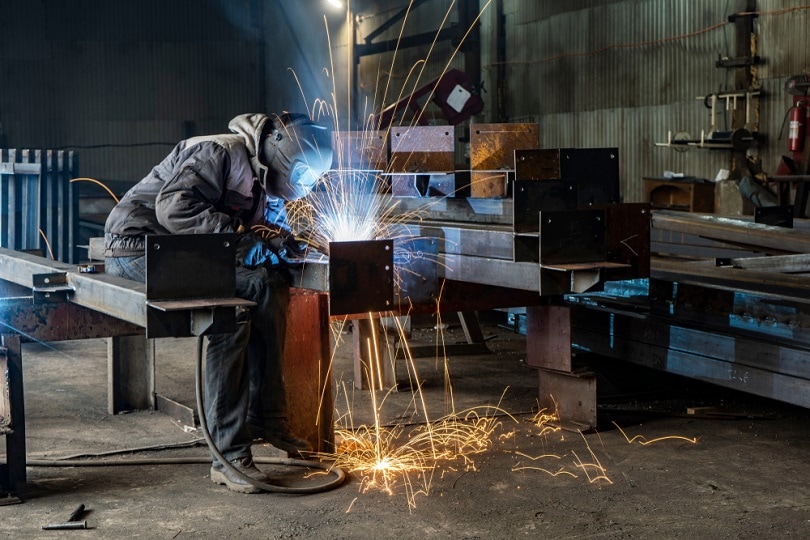
It helps form an outer “shelf” to grasp the melted pool inside as it cools to create a stronger bond. If you’re welding vertically up or overhead, this welding process is the best.
Which Metals Can You Weld Using Dual Shield Welding?
You can use cast iron, hard-facing alloys, stainless steel, and numerous carbon steels with the flux core arc welding process. Nonetheless, you cannot weld exotic non-ferric metals like aluminum with this welding approach.
How Do You Transform a MIG Welder to Flux Core Arc Welding?
In case you want to use a MIG welding machine, change the rollers to a suitable size. Besides having a suitable size for the rollers, the rollers’ tension settings shouldn’t be too taut. If they’re too tight, the anode may get crushed in the rollers leading to issues in the weld.
When adjusting the roller’s tension, they should be sufficiently loose in a way that they’ll facilitate slipping if the wire is stopped. On the other hand, tension at the joint should be sufficiently tight to ensure wire feeding.
However, make sure that it doesn’t interrupt the wire velocity, allowing a steady arc. Don’t forget the nozzle, liner, and tip if need be.
What Are the Transfer Types in Dual Shield Welding?
There are two metal conveyance types used if you’re welding with a flux-cored anode. The types of transfer are Globular and Spray Transfer. The most commonly used transfer type is Spray Transfer.
As the name suggests, the metal in the anode gets heated in a way that sprays the filler metal onto the joint. When it comes to Globular Transfer, the anode gets heated sufficiently sultry to a point that globs of metal drip from the anode to the weld joint. What sets apart the two types of transfer are wire velocity, voltage adjustments, and the gases used, if any.
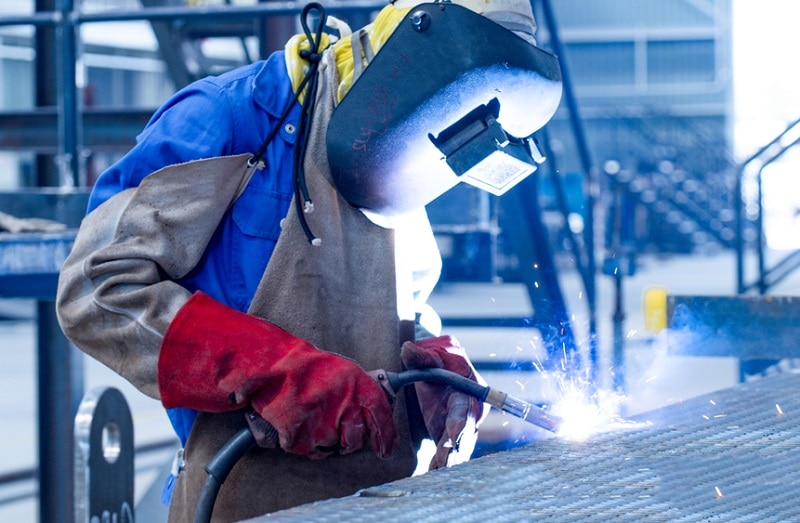
Welding Tips for Flux Core Arc Welding
Here are several tips that’ll help you enhance your weld seams when it comes to Flux Core Arc Welding.
- Be heedful when it comes to wiping off slag after every pass.
- Rather than pushing forward, pull the gun for backhand welds.
- Try to maintain a quick travel velocity when it comes to overhead welds.
- Usually, MIG welding is anode positive. If you’re a welder and you need to change to dual shield welding, you need to make sure that anode polarity is negative before you begin.
- Rather than using sleek wire drive rolls, use knurled drive rolls where possible.
- You can angle up and down if you want to create vertical welds. Weld down vertically if have thinner metals. If you have metals thicker than ¼-inch, weld up. Additionally, ensure that you switch parameters down 10 to 15% on the welding appliance.
- You should only put ½ to ¾-inch of cable to stick out.
- If you want to produce level welds, ensure that you weld at 90 to 10 degrees back. Weld at 45 degrees if you want T joints. When it comes to lap joints, weld at between 60 and 70 degrees in one straight weld.
- To avoid undercut using the gun, weld in a side-to-side movement.
- Make sure that you point the gun upwards at about 10 degrees if you’re working on flat angles. On the welding machine, turn the parameters down around 10 to 15%.
- Use Flux Core Arc Welding in limited spaces or indoors. To avoid risking your health, make sure that there’s sufficient ventilation in your workshop.
- When it comes to outdoor use and connecting thicker materials, dual shield welding is the best technique as compared to MAG welding.
- In this process, the filler wire comes with built-in shielding and, therefore, the procedure can withstand strong breezes.
- The machine used in Flux Core Arc Welding is portable and expedient as it doesn’t have a shielding gas.
- You can use the process with numerous alloy compositions than MAG. It implies that the procedure is flexible.
- This process also offers enhanced arc stability and higher deposition rates. It allows for high-velocity applications without adversely influencing the excellent quality of the weld.
- It’s an “all position” procedure. Also, it needs less expertise among welders as compared to MAG and MMA.
- With this welding process, you only require minimal pre-cleaning of metals as compared to other procedures.
- If dual shield welding is applied well, the likelihood of porosity is also low.
- This welding process generates harmful smoke that makes it hard to perceive the weld pool. Usually, dual shield welding produces more smoke than MAG or MMA welding.
- If the gases from the weld metal are unable to evade before the weld metal turns to solid, porosity can be an issue.
- Compared to solid wire anodes, dual shield welding electrodes need to be handled and stored well.
- Because of its cannular nature, the filler material can at times be costly as compared to its solid counterparts.
- To guarantee the required mechanical characteristics, you have to select the right filler material.
- You also need to ensure constant wire feeding to avoid issues related to the weld.
- Before you deposit every subsequent stratum, you have to get rid of slag formation.
- Although the procedure is excellent when it comes to connecting thicker metals, it’s not suggested to use materials thinner than 20 gauges.
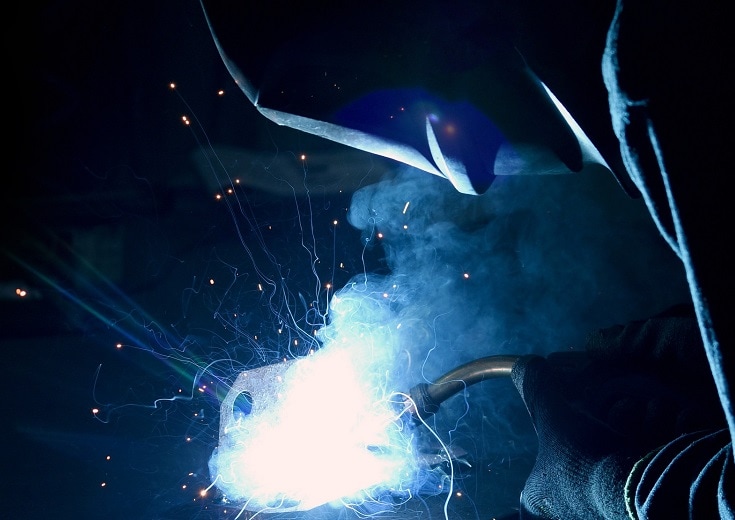
FAQs
When it Comes to Dual Shield Welding, Do You Weld Both Sides?
If possible, always ensure you weld the two sides. It creates a stronger joint as compared to a single-sided welded joint.
What’s the Difference Between Dual Shield and Flux Core?
Metalcore cable is a hollow cannular wire infused with metal oxides in them. It requires a shielding gas. Dual shield (flux core cable) is also a hollow tubular. However, it’s infused with fluxing agents comparable to flux on smaw anodes. It needs a shielding gas, and also the gas generated from the flux of the wire.
Is Flux Core Arc Welding Better as Compared to MIG Welding?
You can weld thicker metals at low amperage with dual shield welding than MIG welding. It implies that the contention that flux core has improved penetration of the metal is equally justifiable.
What Leads to Wormholes in Dual Shield Welding?
Usually, wormholes permeability takes place in the dual shield welding procedure on both gases shielded and self-shielded applications. This condition is commonly caused by nitrogen if it’s ensnared as it attempts to elude the puddle in the solidification procedure.
Is Dual Shield Welding Good?
Flux Core Arc welding procedure provides greater penetration and, therefore, it’s great for working with thicker joints. In the process, the welder can move in all directions.
They can also grasp the torch in a couple of directions. It makes it fit for usual repairs, shipbuilding, and other fabrication types.

A Quick Reference Guide
When to Use Dual Shield Welding
When to Use MIG Welding
If you have thicker metals or in out-of-position applications
When you have thin metals such as stainless steel, aluminum, and steel
If you’re carrying out the usual repairs, building ships, and in other types of fabrications
If you want to produce high-strength welds that provide an excellent appearance
When you want to deposit 8 pounds of wire every hour when welding
If you want to deposit 25 pounds of wire in one hour when welding
If you don’t have a gas tank
When you have a shielding gas tank
Conclusion
Dual shield welding is a semi-automatic welding procedure that’s comparable to MAG welding. It uses a constantly-fed cable anode, a continuous voltage welding power output, and gear comparable to MAG welding.
Dual shield welding utilizes a protective gas akin to that used in MAG welding. However, you can also perform it without the protective gas. The procedure is more productive as compared to MAG welding.
Check out some of our other top-trending posts:
- What is Friction Stir Welding (FSW)? How Does it Work? (2021)
- What’s a Full Penetration Weld? 2021 Guide
- What is Friction Welding? Understanding it Thoroughly
Featured Image: YAKISTUDIO, Shutterstock
